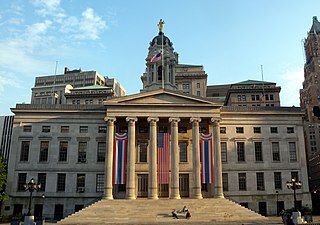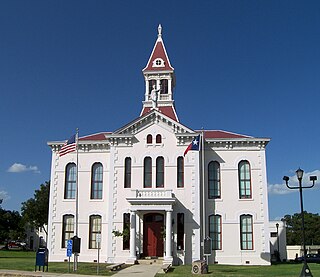Comal County Courthouse | |
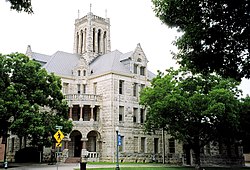 Comal County Courthouse in 2006 | |
| Location | 150 N. Seguin Ave., New Braunfels, Texas |
|---|---|
| Coordinates | 29°42′12″N98°7′29″W / 29.70333°N 98.12472°W Coordinates: 29°42′12″N98°7′29″W / 29.70333°N 98.12472°W |
| Area | 1 acre (0.40 ha) |
| Built | 1897 |
| Architect | James Riely Gordon |
| Architectural style | Romanesque |
| NRHP reference # | 76002017 [1] |
| TSAL # | 8200000175 |
| RTHL # | 987 |
| Significant dates | |
| Added to NRHP | December 12, 1976 |
| Designated TSAL | January 1, 1981 |
| Designated RTHL | 1993 |
The Comal County Courthouse is located in New Braunfels in the U.S. state of Texas. It was added to the National Register of Historic Places in Comal County, Texas in 1976 and designated a Recorded Texas Historic Landmark in 1993. [2]

New Braunfels is a city in Comal and Guadalupe counties in the U.S. state of Texas, located in the northeastern part of Greater San Antonio. It is the seat of Comal County and 32 miles (51 km) from Downtown San Antonio. The city covers 44.9 square miles (116 km2) and has a 2018 estimated population of 84,612.

In the United States, a state is a constituent political entity, of which there are currently 50. Bound together in a political union, each state holds governmental jurisdiction over a separate and defined geographic territory and shares its sovereignty with the federal government. Due to this shared sovereignty, Americans are citizens both of the federal republic and of the state in which they reside. State citizenship and residency are flexible, and no government approval is required to move between states, except for persons restricted by certain types of court orders.
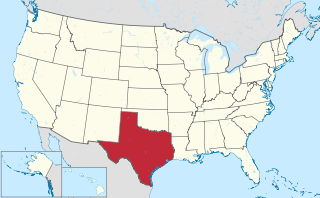
Texas is the second largest state in the United States by area and population. Geographically located in the South Central region of the country, Texas shares borders with the U.S. states of Louisiana to the east, Arkansas to the northeast, Oklahoma to the north, New Mexico to the west, and the Mexican states of Chihuahua, Coahuila, Nuevo León, and Tamaulipas to the southwest, and has a coastline with the Gulf of Mexico to the southeast.
Contents
Comal County has had two courthouses. The first was designed by Wilhelm Thielepape and completed circa 1860, but had deteriorated in condition by the late 1890s. [3] The current Romanesque Revival style courthouse was designed by James Riely Gordon and completed in 1898 by contractors Fischer and Lamie. Gordon, along with another San Antonio architect Albert Felix Beckmann, [4] submitted bids to replace the courthouse designed by Thielepape. In addition to reviewing the bids, the county commissioners traveled to Gonzales to assess the architectural quality of the Gonzales County Courthouse, a work designed by Gordon and completed in 1896. [5]

Wilhelm Carl August Thielepape, was an architect, engineer, teacher, photographer, and lithographer. He was mayor of San Antonio, Texas, during part of the Reconstruction era, and later an attorney in Chicago, Illinois.

Romanesque Revival is a style of building employed beginning in the mid-19th century inspired by the 11th- and 12th-century Romanesque architecture. Unlike the historic Romanesque style, however, Romanesque Revival buildings tended to feature more simplified arches and windows than their historic counterparts.
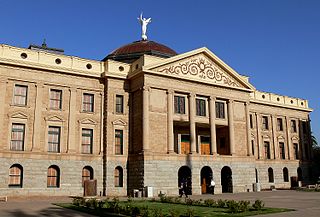
James Riely Gordon was an architect who practiced in San Antonio until 1902 and then in New York City, where he established a national reputation. J. Riely Gordon is best known for his landmark county courthouses, in particular those in Texas. Working during the state's "Golden Age" (1883–1898) of courthouse construction, Gordon saw 18 of his designs erected from 1885 to 1901; today 12 remain.
The courthouse was restored to its original appearance in 2013 after a three-year, $8.7 million undertaking that included removing two additions, and restoring or replicating paint, tile, doors and furniture. [6] Atop the three-story building is a corniced stone tower. [5] [7]
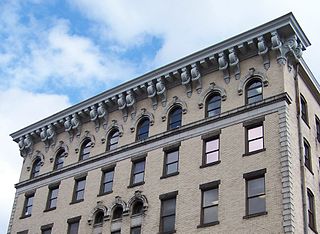
In architecture, a cornice is generally any horizontal decorative molding that crowns a building or furniture element – the cornice over a door or window, for instance, or the cornice around the top edge of a pedestal or along the top of an interior wall. A simple cornice may be formed just with a crown.




